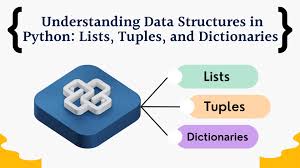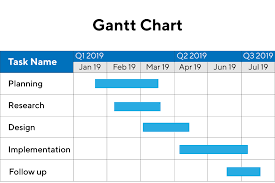Project Management Tools: Gantt Charts
21-Apr-2025
Understanding Lists, Tuples, and Dictionaries in Python
07-Mar-2025
Ask Gemini, not Google assistant!
03-Mar-2025
Goodbye Skype: End of an Era and What It Means for You
14-Jan-2025
Best VPN Services
02-Apr-2024
X Announces Grok-1.5
25-Mar-2024
Safaricom Introduces Standing Orders
18-Mar-2024
Staying Safe Online
Understanding Lists, Tuples, and Dictionaries in Python

List, Tuples and Dictionaries are Python data structures that allow for the organization and management of data in an efficient manner. They serve as essential building blocks for developing complex software applications, enabling effective data manipulation and streamlined problem-solving. The choice of an appropriate data structure is key as it can significantly impact the performance and readability of your code. In this post, I'll provide an explanation of three core data structures in Python: lists, tuples, and dictionaries. These structures are indispensable tools for Python programmers, and a thorough understanding of their properties and applications is crucial for writing robust and efficient code.
What is a List?
A list in Python is defined as a mutable, ordered sequence of elements. It is a multipurpose data structure that can hold a collection of items. Items in a list can be of any data type, including integers, strings, floating-point numbers, or even other lists. Lists are created using square brackets [], with individual elements separated by commas. For instance, fruits= ['banana', 'orange', 'pawpaw'] defines a list of strings.
The ability of lists to accommodate multiple data types distinguishes them from more rigid array structures found in other programming languages. This flexibility allows programmers to group diverse, yet related pieces of information within a single collection.
Lists in Python maintain the order in which elements are added. This ordered nature means that each element in a list has a specific position, known as its index The index in a list starts from 0 for the first element. This indexing allows for direct access to any element in the list by referring to its index. For example, in the fruits list above, the element at index 1 is 'orange'. Python also supports negative indexing, which enables access to elements from the end of the list, with -1 referring to the last element.
Another characteristic of Python lists is their mutability. This means that the contents of a list can be changed after it has been created. Elements within a list can be modified by assigning a new value to a specific index. For example;
cars=['Toyota', 'Volvo','Tesla'] cars[1]='Mercede'The above statement would change the second element of the list and assign it a value Mercede.
Additionally, items can be added to the end of a list using methods like append() or inserted at a specific position using insert(). Conversely, elements can be removed from a list using methods like remove() or pop() , or by using the del statement. This dynamic nature of lists makes them highly adaptable for managing collections of data that may need to grow, shrink, or be modified during the execution of a program. However, it is important to be aware of the implications of mutability, particularly when multiple variables refer to the same list object (aliasing), as changes made through one variable will be reflected in the others.
Importance of Lists
Lists are importance in the following ways;- Lists provide a way to group data that belongs together. This makes the code more organized and easy to manage
- It is easier to perform operations on multiple values in a list through iteration
- Lists are dynamic. This makes them useful in scenarios where amount of data is not know before hand.
- In Python, lists can be employed to implement other data structures such as stacks and queues
What is a Tuple?
A tuple in Python is defined as an immutable, ordered collection of elements. Similar to lists, tuples can hold elements of different data types and maintain the order of insertion. Tuples are created using parentheses () instead of square brackets [ ] as with lists. Elements in tuples separated by commas. For example,
coordinates = (40.7128, -74.0060)defines a tuple representing a geographical coordinate.
A key syntax point to note is that a tuple with a single element requires a trailing comma to be recognized as a tuple; otherwise, it is treated as a single value enclosed in parentheses.
Like lists, tuples are ordered sequences, meaning the position of each element is fixed and accessible through indexing, starting from 0. This allows for retrieving specific elements based on their index, just as with lists. For instance, in the coordinates tuple above, coordinates would access the latitude (40.7128). Negative indexing is also supported, allowing access from the end of the tuple.
The most significant difference between tuples and lists lies in their immutability. Once a tuple is created, its elements cannot be changed, added, or removed. Any attempt to modify a tuple will result in a TypeError. This immutability provides several benefits, including ensuring data integrity, allowing tuples to be used as keys in dictionaries (since dictionary keys must be immutable and hashable), and potentially offering slight performance advantages in certain operations.
Tuples are chosen over lists when the data represents a fixed collection that should not be modified after creation. This immutability also makes tuples suitable for use as keys in dictionaries, a capability that lists do not possess because they are mutable and thus not hashable. In addition, Tuples can be used to hold constants or configuration settings that should not change during the program execution. Lists, on the other hand, are preferred when the collection of items is dynamic and requires modifications such as adding or removing elements. Additionally, tuples are often more memory-efficient than lists due to their fixed size
What is a Dictionary?
A dictionary in Python is defined as a mutable,unordered collection of key-value pairs. Unlike lists and tuples, which are indexed by a range of numbers, dictionaries are indexed by keys. The keys in dictionaries can be any immutable type such as strings, numbers, or tuples. Dictionaries are created using curly braces { }. Each key-value pair separated by a colon : and pairs separated by commas. For example,
countryCapitals = {"Kenya": "Nairobi", "Rwanda": "Kigali", "England": "London"}defines a dictionary where country names are keys and their capitals are values.
A fundamental rule is that keys within a dictionary must be unique.
Each key in a dictionary is associated with a specific value. Keys must be immutable to ensure their hash value remains constant, allowing for efficient lookups. Values, however, can be of any data type, including mutable types like lists or even other dictionaries. This structure allows for efficient retrieval of a value based on its associated key, similar to looking up a definition in a physical dictionary using a word as the key.
Starting with Python 3.7, dictionaries are ordered, meaning they remember the order in which key-value pairs were inserted. In earlier versions of Python (before 3.7), dictionaries were unordered, and the order of items was not guaranteed. This change in Python 3.7 made dictionaries more predictable in scenarios where the order of elements matters, such as when serializing data to JSON or maintaining a specific sequence of configuration settings.
Dictionaries are incredibly important in Python due to their efficiency in mapping keys to values, allowing for fast data retrieval. This efficiency is achieved through the use of hash tables, which provide an average time complexity of O(1) for lookups, insertions, and deletions. This makes dictionaries highly suitable for applications dealing with large amounts of data where quick access to specific information is required





